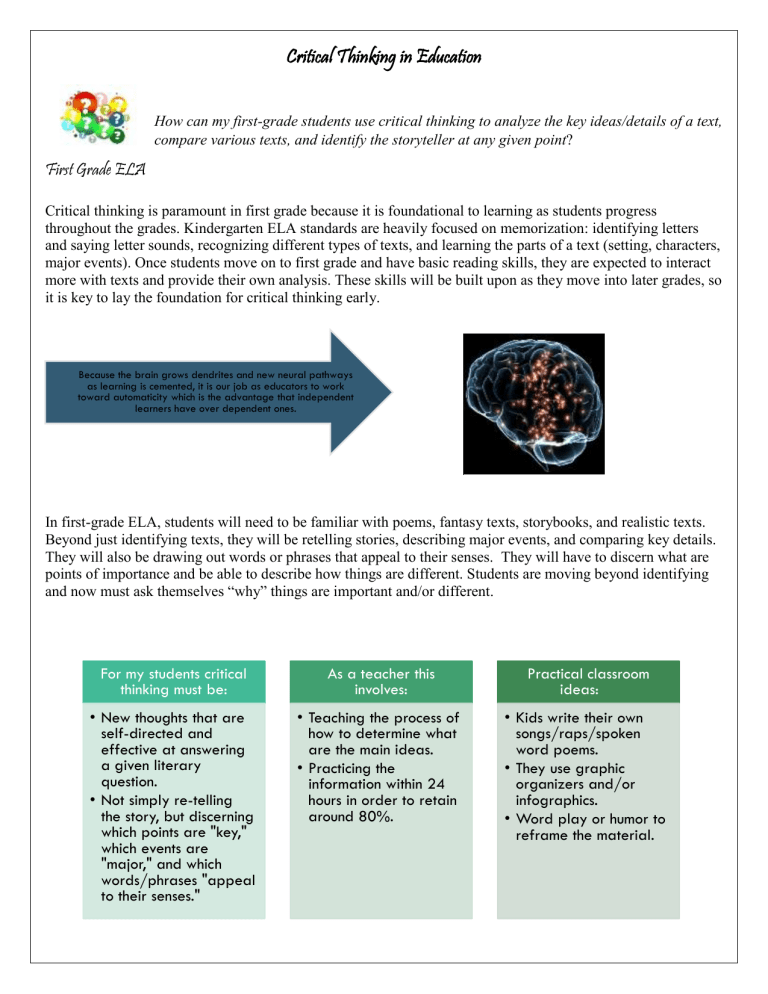
Critical Thinking in Education How can my first-grade students use critical thinking to analyze the key ideas/details of a text, compare various texts, and identify the storyteller at any given point? First Grade ELA Critical thinking is paramount in first grade because it is foundational to learning as students progress throughout the grades. Kindergarten ELA standards are heavily focused on memorization: identifying letters and saying letter sounds, recognizing different types of texts, and learning the parts of a text (setting, characters, major events). Once students move on to first grade and have basic reading skills, they are expected to interact more with texts and provide their own analysis. These skills will be built upon as they move into later grades, so it is key to lay the foundation for critical thinking early. Because the brain grows dendrites and new neural pathways as learning is cemented, it is our job as educators to work toward automaticity which is the advantage that independent learners have over dependent ones. In first-grade ELA, students will need to be familiar with poems, fantasy texts, storybooks, and realistic texts. Beyond just identifying texts, they will be retelling stories, describing major events, and comparing key details. They will also be drawing out words or phrases that appeal to their senses. They will have to discern what are points of importance and be able to describe how things are different. Students are moving beyond identifying and now must ask themselves “why” things are important and/or different. For my students critical thinking must be: As a teacher this involves: Practical classroom ideas: • New thoughts that are self-directed and effective at answering a given literary question. • Not simply re-telling the story, but discerning which points are "key," which events are "major," and which words/phrases "appeal to their senses." • Teaching the process of how to determine what are the main ideas. • Practicing the information within 24 hours in order to retain around 80%. • Kids write their own songs/raps/spoken word poems. • They use graphic organizers and/or infographics. • Word play or humor to reframe the material. 4 COMPONENTS of CRITICAL THINKING: Ignite - tell the brain it's time for a learning cycle (chant/music clip/pair-share) Chunk - break the information into small segments so students aren't overloaded Chew - unstructured think time to rest with the information Review - go over the information within 24 hrs. (draw connections/find patterns) While the concept of critical thinking seems straightforward (complete the four steps mentioned above for any given topic), it’s success can vary greatly based on the classroom demographic. Students who were raised in language and print-rich environment would likely have already been exposed to the variety of texts discussed in the ELA curriculum. They would have been asked open-ended questions by their parents while listening to read-alouds. Those students would be immersed in age-appropriate books while challenged with advanced vocabulary during family discussions. Low S.E.S. Background This is not the case for many students coming from a low socioeconomic background, English learners, or those in foster care. In the case of my son, who came to us at age three, he had never seen a book and did not know what they were. He was non-verbal and had not Children English in Foster experienced healthy touch or a nurturing environment. In watching his Learners Care challenges, I have seen that while children can make great strides once exposed to books, language, and a loving home, the part of the brain that processes higher-level reasoning (i.e. critical thinking) may have been severely stunted in their formative years. The dendrites and neural pathways simply were not created and so these kids are “growing their brains” from the ground up. For such children, there can also be many triggers around the productive struggle that Hamon states is necessary for kids to reach conclusions on their own. When my son doesn’t know something or feels left behind, he shuts down completely and it is very difficult to get him to engage emotionally or academically. Students from hard places will need scaffolding and felt trust built with their teacher in order to overcome these obstacles to learning. Works Cited 1. Hammond, Zaretta L. “Culturally Responsive Teaching and the Brain: Promoting Authentic Engagement and Rigor Among Culturally and Linguistically Diverse Students” (1st Edition), 2014. 2. Willingham, D.T. “Ask the Cognitive Scientist: How Can Educators Teach Critical Thinking, America Educator,” 2020.




